| Western blot (WB): | 1:500-2000 |
| Immunohistochemistry (IHC): | 1:50-400 |
| Immunocytochemistry/Immunofluorescence (ICC/IF): | 1:50-400 |
| Flow Cytometry (Fixed): | 1:50-200 |
| (Boiling the paraffin sections in 10mM citrate buffer,pH6.0,or PH8.0 EDTA repair liquid for 20 mins is required for the staining of formalin/paraffin sections.) Optimal working dilutions must be determined by end user. | |

Western blot analysis of STAT3 using anti-STAT3 antibody (PB0540). The sample well of each lane was loaded with 30 ug of sample under reducing conditions.
Lane 1: human HEL whole cell lysates,
Lane 2: human A549 whole cell lysates,
Lane 3: human Hacat whole cell lysates,
Lane 4: human U251 whole cell lysates,
Lane 5: human K562 whole cell lysates,
Lane 6: human SiHa whole cell lysates,
Lane 7: human RT4 whole cell lysates.
After electrophoresis, proteins were transferred to a membrane. Then the membrane was incubated with rabbit anti-STAT3 antigen affinity purified polyclonal antibody (PB0540) at a dilution of 1:1000 and probed with a goat anti-rabbit IgG-HRP secondary antibody (Catalog # BA1054). The signal is developed using ECL Plus Western Blotting Substrate (Catalog # AR1197). A specific band was detected for STAT3 at approximately 88 kDa. The expected band size for STAT3 is at 88 kDa.

Western blot analysis of STAT3 using anti-STAT3 antibody (PB0540). The sample well of each lane was loaded with 30 ug of sample under reducing conditions.
Lane 1: human Hela- WT whole cell lysates,
Lane 2: human Hela-STAT3 KO whole cell lysates.
After electrophoresis, proteins were transferred to a membrane. Then the membrane was incubated with rabbit anti-STAT3 antigen affinity purified polyclonal antibody (PB0540) at a dilution of 1:1000 and probed with a goat anti-rabbit IgG-HRP secondary antibody (Catalog # BA1054). The signal is developed using ECL Plus Western Blotting Substrate (Catalog # AR1197). A specific band was detected for STAT3 at approximately 88 kDa. The expected band size for STAT3 is at 88 kDa.
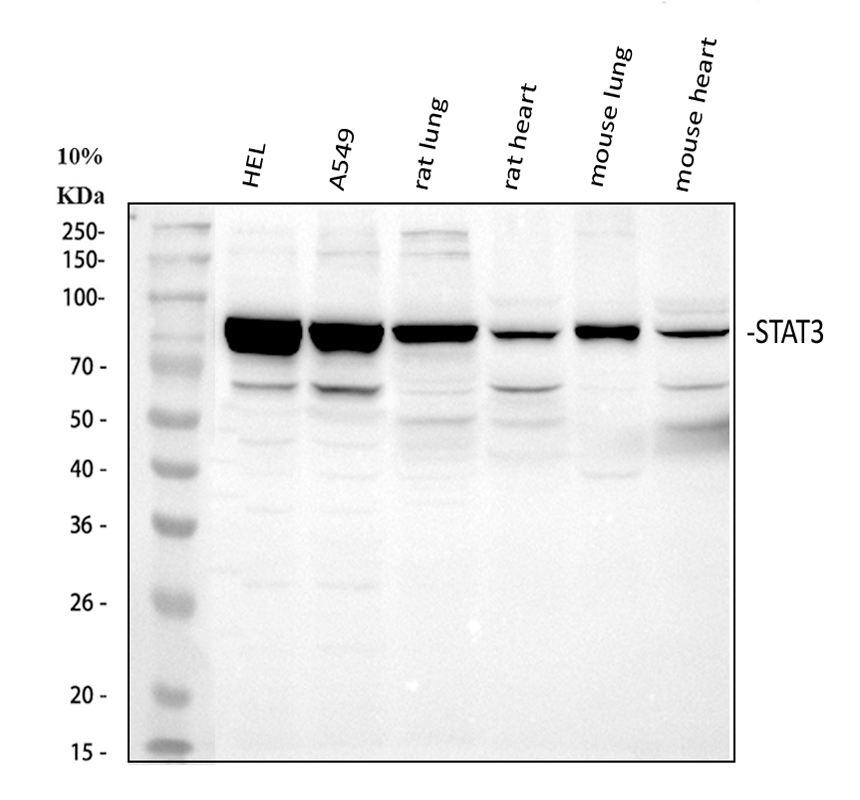
Western blot analysis of STAT3 using anti-STAT3 antibody (PB0540). The sample well of each lane was loaded with 30 ug of sample under reducing conditions.
Lane 1: human HEL whole cell lysates,
Lane 2: human A549 whole cell lysates,
Lane 3: rat lung tissue lysates,
Lane 4: rat heart tissue lysates,
Lane 5: mouse lung tissue lysates,
Lane 6: mouse heart tissue lysates.
After electrophoresis, proteins were transferred to a membrane. Then the membrane was incubated with rabbit anti-STAT3 antigen affinity purified polyclonal antibody (PB0540) at a dilution of 1:1000 and probed with a goat anti-rabbit IgG-HRP secondary antibody (Catalog # BA1054). The signal is developed using ECL Plus Western Blotting Substrate (Catalog # AR1197). A specific band was detected for STAT3 at approximately 88 kDa. The expected band size for STAT3 is at 88 kDa.
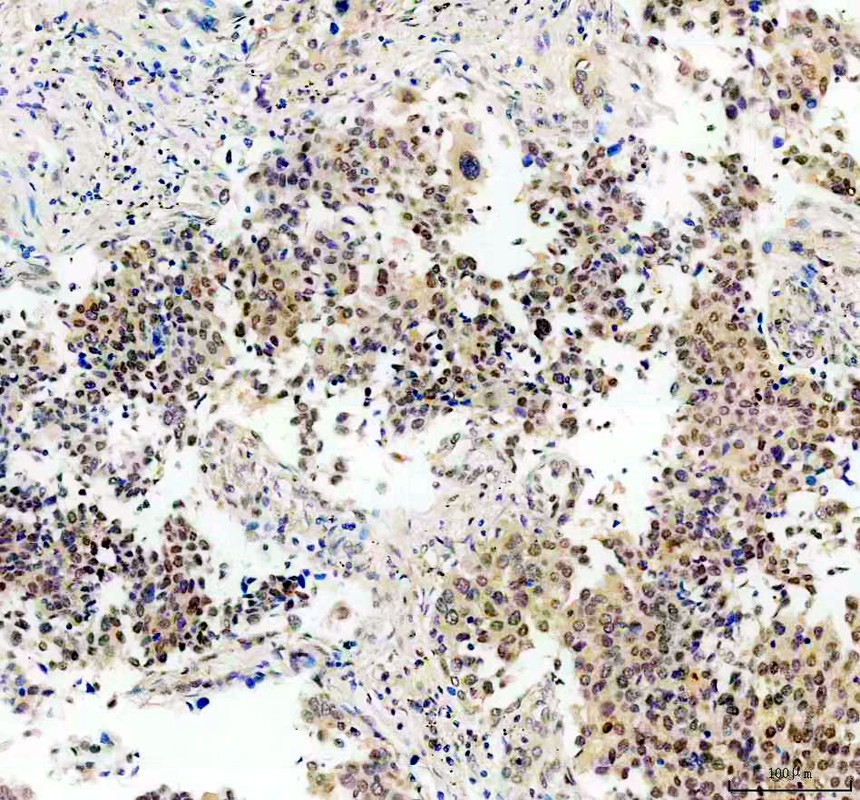
IHC analysis of STAT3 using anti-STAT3 antibody (PB0540).
STAT3 was detected in a paraffin-embedded section of human lung cancer tissue. The tissue section was incubated with rabbit anti-STAT3 Antibody (PB0540) at a dilution of 1:200 and developed using HRP Conjugated Rabbit IgG Super Vision Assay Kit (Catalog # SV0002) with DAB (Catalog # AR1027) as the chromogen.
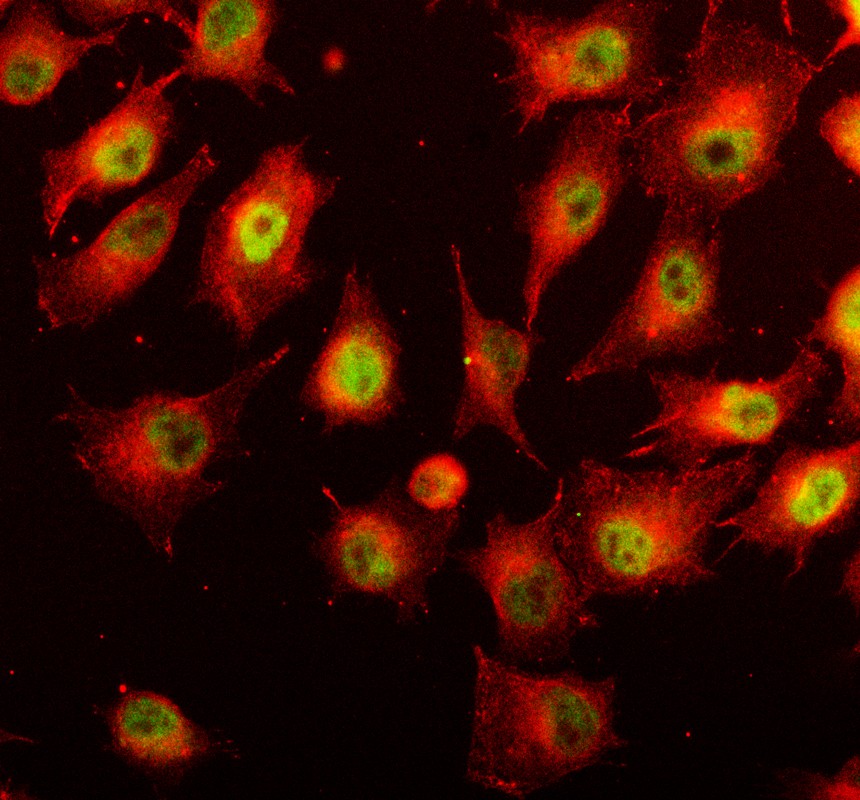
ICC/IF analysis of STAT3 using anti-STAT3 antibody (PB0540) and anti-Beta Tubulin antibody (M01857-3).
STAT3 was detected in an immunocytochemical section of A549 cells. The section was incubated with rabbit anti-STAT3 Antibody (PB0540) at a dilution of 1:100. Fluoro488-conjugated Anti-rabbit IgG Secondary Antibody (green)(Catalog#BA1127) and Fluoro594-conjugated Anti-mouse IgG Secondary Antibody (red)(Catalog#BA1141) were used as secondary antibody.
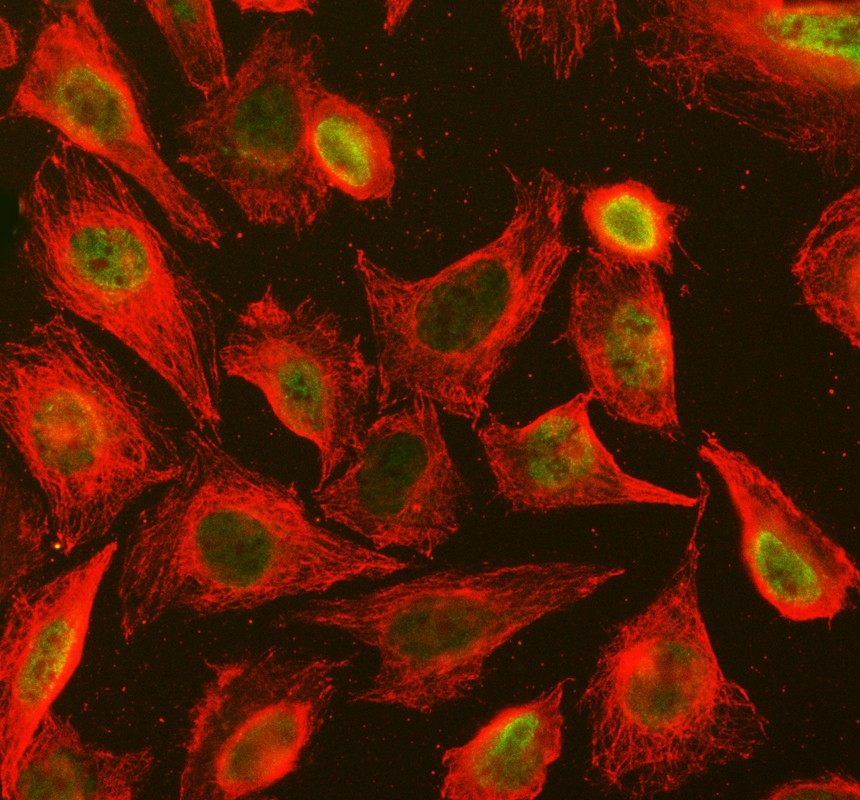
ICC/IF analysis of STAT3 using anti-STAT3 antibody (PB0540) and anti-Beta Tubulin antibody (M01857-3).
STAT3 was detected in an immunocytochemical section of U2OS cells. The section was incubated with rabbit anti-STAT3 Antibody (PB0540) at a dilution of 1:100. Fluoro488-conjugated Anti-rabbit IgG Secondary Antibody (green)(Catalog#BA1127) and Cy3-conjugated Anti-mouse IgG Secondary Antibody (red)(Catalog#BA1031) were used as secondary antibody.
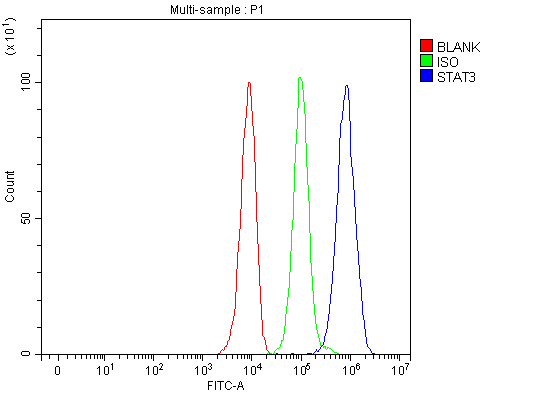
Flow Cytometry analysis of PC-12 cells using anti-STAT3 antibody (PB0540).
Overlay histogram showing PC-12 cells stained with PB0540 (Blue line). To facilitate intracellular staining, cells were fixed with 4% paraformaldehyde and permeabilized with permeabilization buffer. The cells were blocked with 10% normal goat serum. And then incubated with rabbit anti-STAT3 Antibody (PB0540) at 1:100 dilution for 30 min at 20°C. Fluoro488 conjugated goat anti-rabbit IgG (BA1127) was used as secondary antibody at 1:100 dilution for 30 minutes at 20°C. Isotype control antibody (Green line) was rabbit IgG at 1:100 dilution used under the same conditions. Unlabelled sample without incubation with primary antibody and secondary antibody (Red line) was used as a blank control.
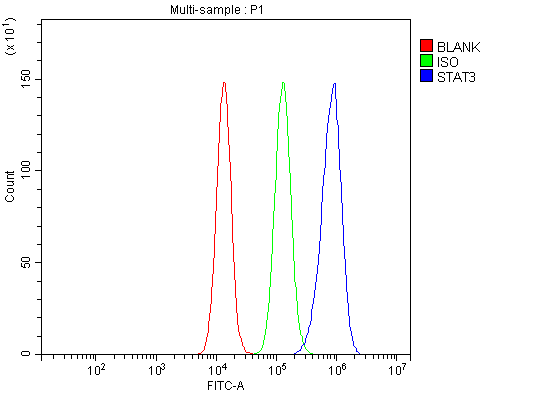
Flow Cytometry analysis of SiHa cells using anti-STAT3 antibody (PB0540).
Overlay histogram showing SiHa cells stained with PB0540 (Blue line). To facilitate intracellular staining, cells were fixed with 4% paraformaldehyde and permeabilized with permeabilization buffer. The cells were blocked with 10% normal goat serum. And then incubated with rabbit anti-STAT3 Antibody (PB0540) at 1:100 dilution for 30 min at 20°C. Fluoro488 conjugated goat anti-rabbit IgG (BA1127) was used as secondary antibody at 1:100 dilution for 30 minutes at 20°C. Isotype control antibody (Green line) was rabbit IgG at 1:100 dilution used under the same conditions. Unlabelled sample without incubation with primary antibody and secondary antibody (Red line) was used as a blank control.

Western blot analysis of STAT3 using anti-STAT3 antibody (PB0540). The sample well of each lane was loaded with 30 ug of sample under reducing conditions.
Lane 1: human HEL whole cell lysates,
Lane 2: human A549 whole cell lysates,
Lane 3: human Hacat whole cell lysates,
Lane 4: human U251 whole cell lysates,
Lane 5: human K562 whole cell lysates,
Lane 6: human SiHa whole cell lysates,
Lane 7: human RT4 whole cell lysates.
After electrophoresis, proteins were transferred to a membrane. Then the membrane was incubated with rabbit anti-STAT3 antigen affinity purified polyclonal antibody (PB0540) at a dilution of 1:1000 and probed with a goat anti-rabbit IgG-HRP secondary antibody (Catalog # BA1054). The signal is developed using ECL Plus Western Blotting Substrate (Catalog # AR1197). A specific band was detected for STAT3 at approximately 88 kDa. The expected band size for STAT3 is at 88 kDa.

Western blot analysis of STAT3 using anti-STAT3 antibody (PB0540). The sample well of each lane was loaded with 30 ug of sample under reducing conditions.
Lane 1: human Hela- WT whole cell lysates,
Lane 2: human Hela-STAT3 KO whole cell lysates.
After electrophoresis, proteins were transferred to a membrane. Then the membrane was incubated with rabbit anti-STAT3 antigen affinity purified polyclonal antibody (PB0540) at a dilution of 1:1000 and probed with a goat anti-rabbit IgG-HRP secondary antibody (Catalog # BA1054). The signal is developed using ECL Plus Western Blotting Substrate (Catalog # AR1197). A specific band was detected for STAT3 at approximately 88 kDa. The expected band size for STAT3 is at 88 kDa.

Western blot analysis of STAT3 using anti-STAT3 antibody (PB0540). The sample well of each lane was loaded with 30 ug of sample under reducing conditions.
Lane 1: human HEL whole cell lysates,
Lane 2: human A549 whole cell lysates,
Lane 3: rat lung tissue lysates,
Lane 4: rat heart tissue lysates,
Lane 5: mouse lung tissue lysates,
Lane 6: mouse heart tissue lysates.
After electrophoresis, proteins were transferred to a membrane. Then the membrane was incubated with rabbit anti-STAT3 antigen affinity purified polyclonal antibody (PB0540) at a dilution of 1:1000 and probed with a goat anti-rabbit IgG-HRP secondary antibody (Catalog # BA1054). The signal is developed using ECL Plus Western Blotting Substrate (Catalog # AR1197). A specific band was detected for STAT3 at approximately 88 kDa. The expected band size for STAT3 is at 88 kDa.

IHC analysis of STAT3 using anti-STAT3 antibody (PB0540).
STAT3 was detected in a paraffin-embedded section of human lung cancer tissue. The tissue section was incubated with rabbit anti-STAT3 Antibody (PB0540) at a dilution of 1:200 and developed using HRP Conjugated Rabbit IgG Super Vision Assay Kit (Catalog # SV0002) with DAB (Catalog # AR1027) as the chromogen.

ICC/IF analysis of STAT3 using anti-STAT3 antibody (PB0540) and anti-Beta Tubulin antibody (M01857-3).
STAT3 was detected in an immunocytochemical section of A549 cells. The section was incubated with rabbit anti-STAT3 Antibody (PB0540) at a dilution of 1:100. Fluoro488-conjugated Anti-rabbit IgG Secondary Antibody (green)(Catalog#BA1127) and Fluoro594-conjugated Anti-mouse IgG Secondary Antibody (red)(Catalog#BA1141) were used as secondary antibody.

ICC/IF analysis of STAT3 using anti-STAT3 antibody (PB0540) and anti-Beta Tubulin antibody (M01857-3).
STAT3 was detected in an immunocytochemical section of U2OS cells. The section was incubated with rabbit anti-STAT3 Antibody (PB0540) at a dilution of 1:100. Fluoro488-conjugated Anti-rabbit IgG Secondary Antibody (green)(Catalog#BA1127) and Cy3-conjugated Anti-mouse IgG Secondary Antibody (red)(Catalog#BA1031) were used as secondary antibody.

Flow Cytometry analysis of PC-12 cells using anti-STAT3 antibody (PB0540).
Overlay histogram showing PC-12 cells stained with PB0540 (Blue line). To facilitate intracellular staining, cells were fixed with 4% paraformaldehyde and permeabilized with permeabilization buffer. The cells were blocked with 10% normal goat serum. And then incubated with rabbit anti-STAT3 Antibody (PB0540) at 1:100 dilution for 30 min at 20°C. Fluoro488 conjugated goat anti-rabbit IgG (BA1127) was used as secondary antibody at 1:100 dilution for 30 minutes at 20°C. Isotype control antibody (Green line) was rabbit IgG at 1:100 dilution used under the same conditions. Unlabelled sample without incubation with primary antibody and secondary antibody (Red line) was used as a blank control.

Flow Cytometry analysis of SiHa cells using anti-STAT3 antibody (PB0540).
Overlay histogram showing SiHa cells stained with PB0540 (Blue line). To facilitate intracellular staining, cells were fixed with 4% paraformaldehyde and permeabilized with permeabilization buffer. The cells were blocked with 10% normal goat serum. And then incubated with rabbit anti-STAT3 Antibody (PB0540) at 1:100 dilution for 30 min at 20°C. Fluoro488 conjugated goat anti-rabbit IgG (BA1127) was used as secondary antibody at 1:100 dilution for 30 minutes at 20°C. Isotype control antibody (Green line) was rabbit IgG at 1:100 dilution used under the same conditions. Unlabelled sample without incubation with primary antibody and secondary antibody (Red line) was used as a blank control.







